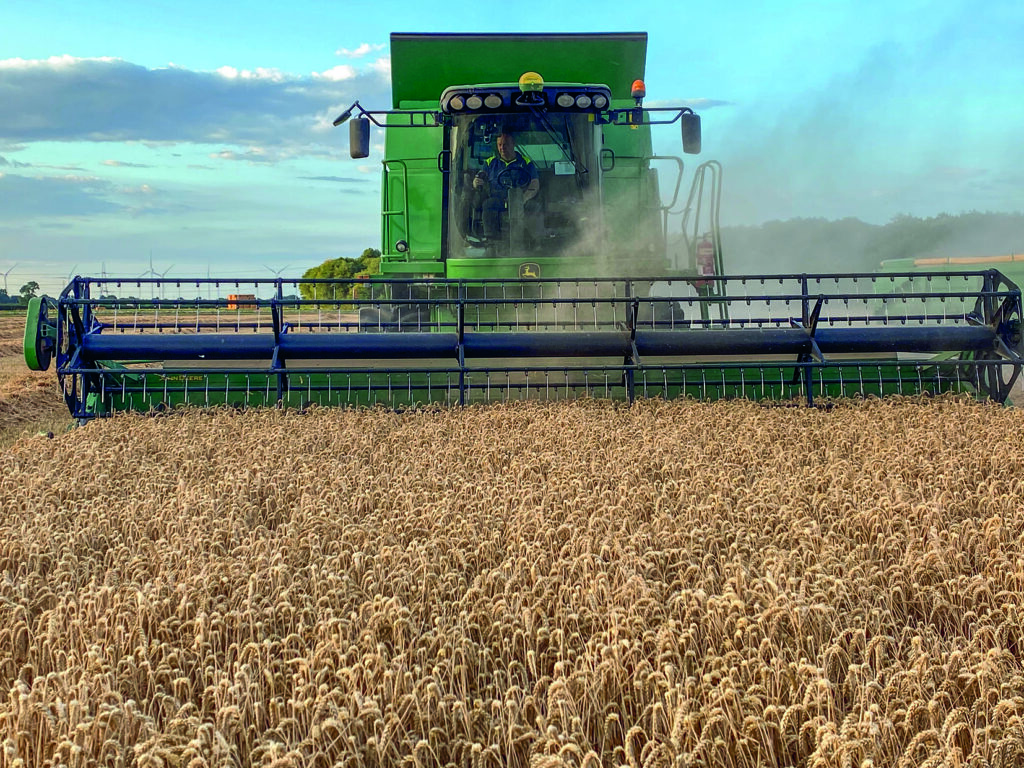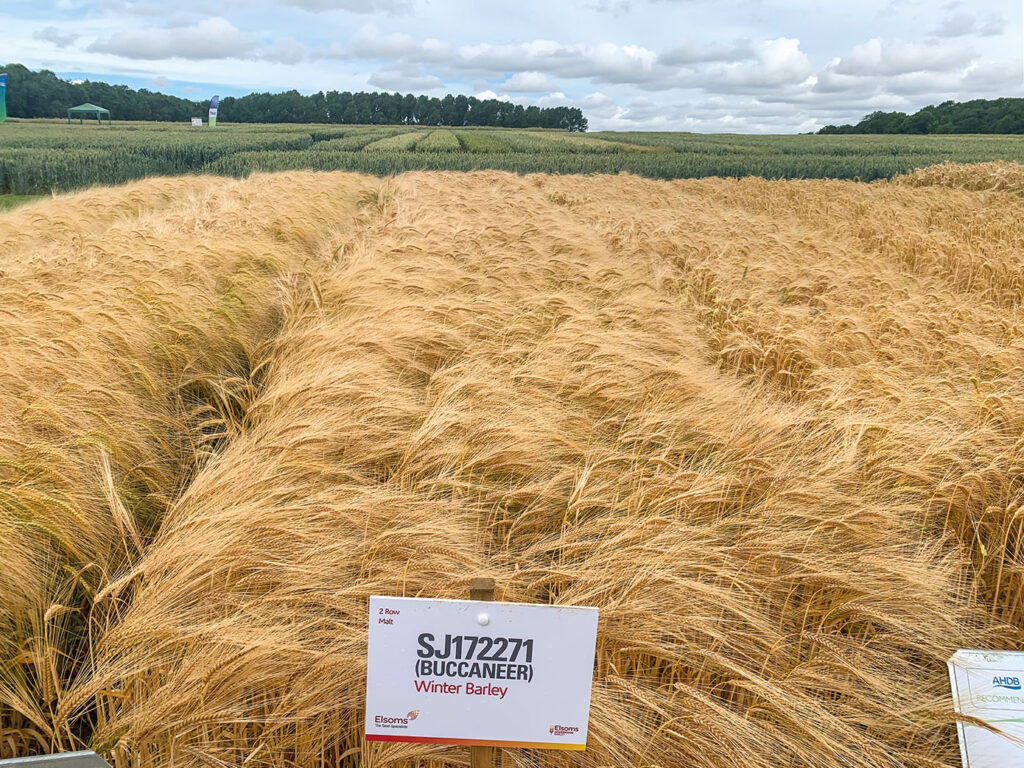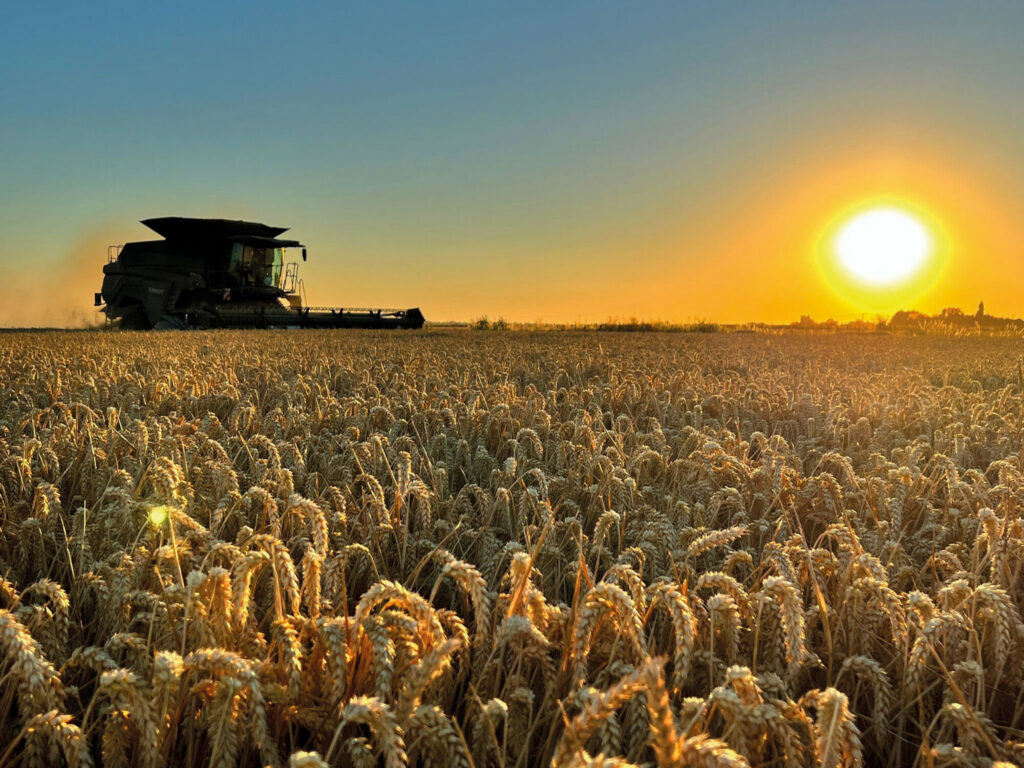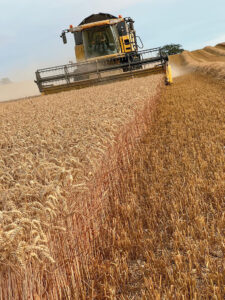Atypical end to season brought an early harvest – but how was yield affected?
2nd October 2022
Record temperatures and a severe lack of rainfall across the summer months led to cereals being harvested up to three weeks’ earlier than usual for some areas of the UK, with field fires in Eastern regions adding extra pressure to bring the grain in.

David Hoyles harvesting LG Astronomer.
The 2021/22 growing season began with little drama – a mild autumn and winter provided adequate rainfall, followed by a warm, dry spring which allowed crops to progress rapidly. Wetter conditions increased the risk for all the key foliar diseases come May, but this rainfall was shortlived as the hotter-than-average and very dry June and July, leading into early August, resulted in early senescence. Although this will have limited yield potential, both breeders and growers are reporting some positive results.
Biscuit wheat performs well on the fens
David Hoyles of GH Hoyles Ltd in Long Sutton, Lincolnshire, was pleased with his late September-drilled seed crop of biscuit wheat LG Astronomer. Two fields harvested on 27–28th July, yielded 13.2–13.4t/ha, and achieved 13.3–13.6% moisture.
The five-year farm average is 11.6t/ha, although Mr Hoyles points out that this does include two lower yielding seasons with very wet autumns and lower levels of radiation in the spring.
Both fields followed vining peas and were min-tilled and drilled in late September.
“We had very little disease at the beginning of the season, so skipped the T0. It was wet in April, so the T1 was more robust, containing Revystar (fluxapyroxad + mefentrifluconazole), Arizona (folpet) and a good dose of PGR,” explains Mr Hoyles.
However, it was dry again by T2, so only Firefly (prothioconazole + fluoxastrobin) and boron were applied.
“An earlier-than-normal T3 at the end of May consisted of Univoq (fenpicoxamid + prothioconazole) and boron.
“We didn’t have any issues with septoria, which we know was a concern with some of the Group 3s last year. As Astronomer is tall, we ensured the PGR programme was robust, and consequently had no problems with lodging.
“We were disappointed that we didn’t have as much soil nitrogen after the vining peas as we had hoped for, meaning the crop received a total of 160kg N/ha which was applied in the seedbed, and three follow up applications.”
New winter barley coped well with extreme weather
Now in its third year of National List trials, new two-row winter malting barley variety Buccaneer coped well with the extreme summer heat, yielding 0.75t/ha ahead of expectations and producing a bold grain according to farm manager Mike Wilton of Stody Estate Limited.
Based in north Norfolk and annually cropping 1,600–1,800ha, the business grew 70ha of winter barley this year, with Buccaneer, a new variety marketed by Elsoms Seeds and bred by Saaten Union, accounting for 20ha of the area.
Mr Wilton says: “Due to a diverse rotation, our area of winter barley can fluctuate each year. However, it’s an important crop for the business, and on our light land we regularly achieve yields of over 7t/ha.
“We drilled [the Buccaneer] into a nice sandy loam on 14th October, following a double break of parsnips and forage maize.
“Although planted 10 days behind our other winter barleys, it established well, competing against a medium weed burden of annual meadow grass, and by late spring it had caught up to our other (mainly) winter feed varieties. As with most of our barleys, it had a two-spray fungicide program consisting of benzovindiflupyr + prothioconazole at 0.6-litres/ha applied at T1 on 15th April, followed by bixafen + fluopyram at 0.75-litres/ha on 21st May. Both SDHI fungicides were applied with some pyraclostrobin in the tank mix for its additional protectant and curative properties.
“Three splits of nitrogen totalling 140kg/ha were applied on 11th February, 9th March and 9th April and, with no signs of disease or heat stress despite the extremely hot summer temperatures, Buccaneer achieved a final yield of 8.25t/ha – ahead of our predictions and around 0.75t/ha ahead of the historical yield expectations for the fields in which it was grown.”

New two-row malting barley, Buccaneer.
Winter wheats demonstrate strong year on-farm
RAGT’s winter wheats have performed well on-farm, despite the exceptionally dry season according to reports from around the country.
The company’s arable product manager, Tom Dummett, says: “Wheat yields in general have been much better than expected, and our new and established varieties have produced some excellent results.
“Rather than cherry-pick the highest yields, we’ve chosen examples that reflect wider experience to indicate what new growers can realistically expect.
“Sufficient rainfall at the right time has been key. But good management that takes account of a variety’s agronomic strengths and weaknesses, plus the consistency across regions, rotational positions and soil types seen in most of our wheats, has played a big part too.”
Andrew Pitts had his second-best wheat harvest at the Grange, Mears Ashby in Northamptonshire, despite receiving just 25mm of rain between May and harvest.
Group 4 newcomer RGT Bairstow grown as a first wheat for seed after peas exceeded 11t/ha across 30ha of medium-bodied soils.
Mr Pitts believes the yield reflects years of soil improvements and the massive amount of sunshine this season.
He says RGT Bairstow was cheap to grow. “We omitted the T0 and the T1, as it was dry and there was no disease to be seen, and followed up with 1.2 litres of Ascra Xpro at T2.
“We’ve doubled the area of Bairstow this coming season. It is a significant advance on some other varieties and has had an excellent first year on farm.”
Ken Goodger trialled 6ha of RGT Bairstow on silt and skirt fen at Pates Farm, Tipps End, Welney, Norfolk.
“The crop was drilled in early December after sugar beet and did phenomenally well, yielding 11–12t/ha,” says Mr Goodger. “It was the best bit of wheat we had.”
Oxfordshire farmer Adrian Taylor has reported another very successful harvest for RAGT’s Group 1 breadmaking wheats at Clattercote Priory Farm, Claydon.
Mr Taylor, who has grown Skyfall for the past eight years and RGT Illustrious for seven, says: “They complement each other well and help spread risk. Skyfall is earlier to harvest, while Illustrious does better on heavier land and can be drilled earlier.”
RGT Illustrious has the edge over Skyfall on disease resistance scores, particularly yellow rust. “But as long as you are on the ball, it is easy enough to control,” Mr Taylor comments.
One 22ha block of Skyfall averaged 10t/ha and a further 33ha averaged 11.6t/ha. The 40ha of RGT Illustrious averaged 10.8t/ha. Protein levels, Hagberg scores and specific weights exceeded specification.

Ken Goodger’s RGT Bairstow was his “best bit of wheat”.
Strong harvest performance despite challenging year
Despite drought conditions towards the end of the growing season and an earlier harvest than in most years, yields have generally held up well across the country, says KWS UK country manager Will Compson (pictured).
“We had finished harvesting all our seed crops at Thriplow, Cambridgeshire, by 10th August, which is a good 10 days earlier than normal,” he explains.
“Despite the challenging conditions later in the season, yields have been strong across most of the country with much of this down to the predominantly good seedbeds crops went into and the amount of sunlight they received throughout the year, particularly in June.
“Although yields have been pleasing, protein levels across the board have suffered as a result of the lack of rainfall in recent weeks combined with the potential cutbacks in nitrogen applied due to the high prices.”
The new Group 4 variety KWS Dawsum, added to the RL at the end of last year, has performed particularly well, he reports.
“KWS Dawsum has performed consistently throughout the UK, delivering 12t/ha plus yields together with specific weights around the 80kg/hl mark with many samples reaching as high as 85kg/hl.
“KWS Cranium has also achieved double-figure yields with many growers appreciating its yellow rust resistance, stiff straw and orange wheat blossom midge resistance.”

Crop of KWS Palladium being harvested at Passmore Brothers’ Mays Farm in Oxfordshire.
The most popular wheat outright for next season will be KWS Extase following another impressive year, Mr Compson reckons.
“KWS Extase’s combination of high treated and untreated yields combined with strong rust and septoria resistances and good grain quality is making it the top choice for all types of growers.
“Our new RL Group 2 variety KWS Palladium has also made a promising start in its first year of commercial production with some yields approaching 14t/ha and good protein levels ensuring its popularity can only grow.”
On the barley front, KWS Tardis has lived up to its promise with many crops on-farm delivering yields to match the best six row hybrids, he says. “We’ve seen yields of over 13t/ha in the East of the country for KWS Tardis, which is truly remarkable considering the year we have had.”
